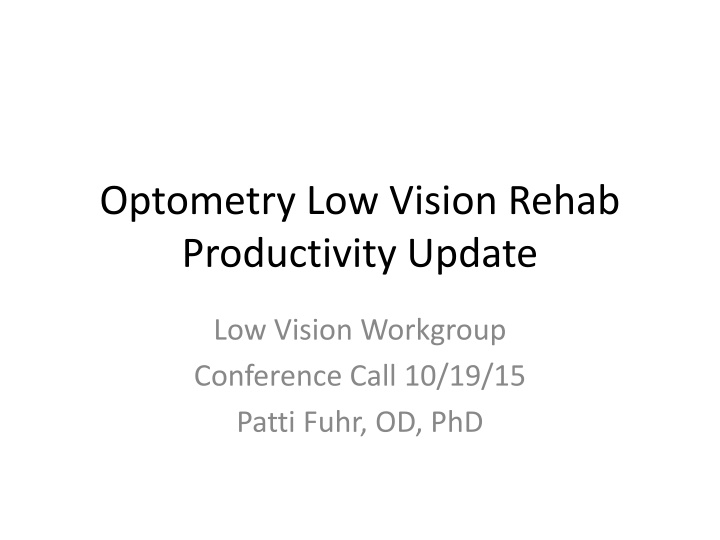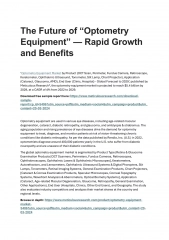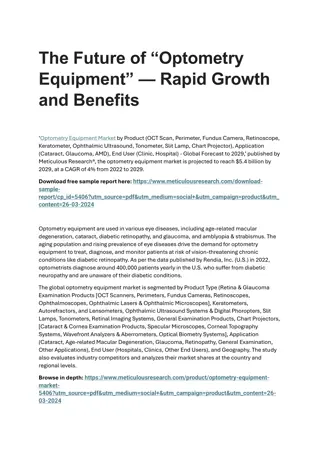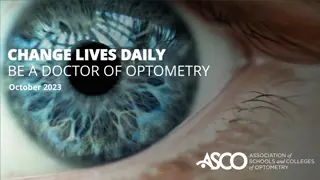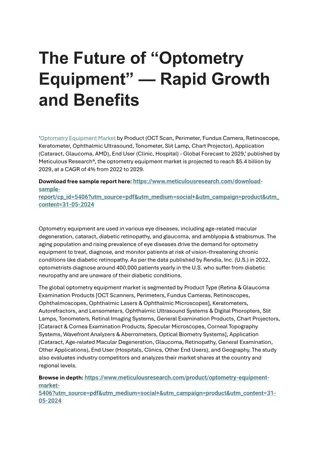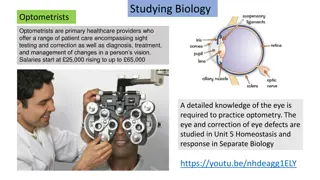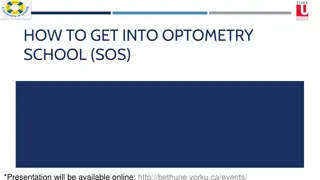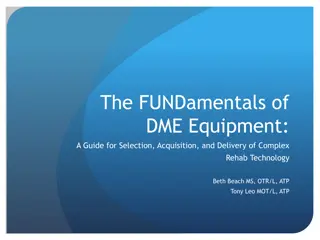Optometry Low Vision Rehab Productivity Update Conference Call Summary
Enhance Optometry productivity by understanding critical elements like Person Class assignments, DSS Labor Mapping, and Resident Only Workload. Efficient classification and mapping help calculate clinical FTE accurately, ensuring optimal resource allocation. Person Class taxonomy, based on NUCC guidelines, defines specialties like Low Vision Rehabilitation and Pediatrics. DSS Labor Mapping determines productivity ratios based on service RVUs generated and clinical FTE. Regular review and update of Person Class data are crucial for accurate productivity calculations. Explore the intersection of technology, specialty services, and workforce optimization in Optometry to improve patient care and efficiency.
Download Presentation

Please find below an Image/Link to download the presentation.
The content on the website is provided AS IS for your information and personal use only. It may not be sold, licensed, or shared on other websites without obtaining consent from the author.If you encounter any issues during the download, it is possible that the publisher has removed the file from their server.
You are allowed to download the files provided on this website for personal or commercial use, subject to the condition that they are used lawfully. All files are the property of their respective owners.
The content on the website is provided AS IS for your information and personal use only. It may not be sold, licensed, or shared on other websites without obtaining consent from the author.
E N D
Presentation Transcript
Optometry Low Vision Rehab Productivity Update Low Vision Workgroup Conference Call 10/19/15 Patti Fuhr, OD, PhD
Critical Elements used to Calculate Productivity 1. Person Class 2. DSS Labor Mapping 3. Resident Only Workload Productivity calculations in the Physician Productivity Cube rely on the accurate classification of an individual provider based on the person class code for their discipline and labor mapping to determine the number of clinical FTE responsible for the workload
Person Class Person Class (Taxonomy) is assigned in the (VistA) NEW PERSON File (http://vaww.aac.va.gov/npcd/) VHA DIRECTIVE 2012-003 Taxonomy is based on NUCC (National Uniform Claim Committee) guidelines http://www.nucc.org/ Chief of Staff Office, C&P Office, Supervisor, AO can assist in reviewing and updating person class (should be reviewed annually) See Attachment 3 Physician Productivity Cube Algorithms Update in VetPro
Optometry Person Class Each attending OD is assigned one person class (practicing specialty). The primary person class for Optometry is 060800. 060800 Optometrist (060800) 060802 Optometrist Low Vision Rehabilitation (060802) 060803 Optometrist Occupational Vision (060803) 060804 Optometrist Pediatrics (060804) 060805 Optometrist Sports Vision (060805) 060806 Optometrist Vision Therapy (060806) 060807 Optometrist Corneal and Contact Management Translation: An OD should be assigned a person class other than 060800 ONLY if practicing that specialty more than 50% of time in clinic
DSS Labor Mapping Productivity is determined by the ratio of specialty service RVUs generated by VA Paid Attendings divided by the adjusted clinical MD FTE of VA Paid Attendings The adjusted clinical MD FTE is derived from DSS Labor Mapping % Clinical, % Administrative, % Education, % Research Clinical MD FTE = Total MD FTE Administrative MD FTE - Education MD FTE - Research MD FTE Translation Productivity is the ratio of the RVUs you generate (based on coding) divided by the amount of time you are mapped for direct patient care
Resident Only Workload Only workload that can be traced back to an attending physician is included in the calculation of productivity the attending physician should be identified as the primary provider on the encounter If a resident is assigned as the primary provider and no attending physician is identified, this workload is not included in the specialty service workload Translation The attending OD should ALWAYS be the primary provider
Specialty Physician Productivity Report To View the report RAMP Search Physician Productivity Cube Specialty Physician Productivity Statistical Process Control (SPC) Charts for Selected Measures Open in Pyramid Analytics Reports: P1. Productivity Data Profile by Specialty Optometry Click to drill down
Specialty Physician Productivity Report P1. Productivity Data Profi... Filter Selection: (All Facility, FY 2015, All Provider Type) RVU Sum, RVUSumFiltered, MD FTE (C), Adjusted MD FTE (C), Productivity Measure, Encounters and RVU Sum Per Encounter by Specialty (Specialty) on rows sub-setted by All Facility, FY 2015 and All Provider Type RVU Sum RVUSumFiltere d 2,648,988.97 12,311.97 MD FTE (C)Adjusted MD FTE (C) 529.44 2.55 Productivity Measure Encounter s RVU Sum Per Encounter Optometrist (060800) Optometrist Corneal and Contact Management (060807) Optometrist Low Vision Rehabilitation (060802) Optometrist Occupational Vision (060803) Optometrist Pediatrics (060804) Optometrist Sports Vision (060805) Optometrist Vision Therapy (060806) 2,905,153.84 12,735.72 529.42 2.55 5,003.55 1,805,825 4,835.85 1.61 1.71 7,440 108,994.03 103,490.24 34.65 34.54 2,996.38 70,547 1.54 1.08 0.65 0.95 1.73 5.4 5 19.45 153.59 8,109.17 19.45 0.19 0.19 103.81 30 161 4,682 7,504.40 1.97 1.97 3,815.96
Productivity Measures for Optometry Low Vision Rehabilitation (060802) The Productivity Measures in the Physician Productivity Cube for Optometry Low Vision Rehabilitation (060802) compared to other Optometry person class categories were significantly lower than for other Optometry person classes, and outside the 25thto 75thpercentile ranges for Fiscal Year (FY)14 and FY15. The productivity values of Low Vision Rehabilitation Optometrists may be influenced by relatively fewer encounters compared to general Optometry due to complexity of patient workload, by coding errors, by erroneous person class, by CMS zero RVU codes for Low Vision Rehabilitation services, or by lack of appropriate codes that reflect the difference between a low vision examination and an eye examination.
Work to clean up the productivity measure Review and correct any errors in person class Review procedure codes and RVUs Work with OPES and DSS to analyze workload and update RVUs Work to implement discipline specific coding so that all VAs have the same guidelines Workgroup established. Starting with person class cleanup
FY 15 Optometrists with Person Class Low Vision BECKER,EMILY N (060802) BELDYGA,BRENT L (060802) JACKOWSKI,MARY (060802) JOHNSON,MATTHEW A (060802) JUN,WEON (060802) KESSLER,SHANNON S (060802) KIRBY,JENNINE E (060802) KLEMENS,JULIE H (060802) KWON,ELLEN E (060802) LEAR,LINDSEY K (060802) LEE,JENNY OD (060802) LIMCHAIYAWAT,PAULA T (060802) LINDSAY,DIANE M (060802) MARTINEZ,BETHANY S (060802) MCCARTHY,MARY (060802) MCCONNAHA,DEBRA L OD (060802) MCKEE,NATALIE K (060802) MESSER,TIMOTHY I (060802) MILLER,AMY M (060802) MONTERROSO,EDDIE A (060802) MORAND,TIMOTHY M (060802) MORDUCHOWITZ,STEVEN (060802) MORSE,STEPHEN E (060802) MURPHY,ANDREA (060802) NGUYEN,THERESE ANNE VY-PHUC T (060802) O'CONNELL,WILLIAM F (060802) PAYNE,SUSAN H (060802) PENA,JULENE (060802) PEREZ,ANA M (060802) PERKINS,ELIZABETH (060802) PETERSON,MICHAEL S (060802) RAKOCZY,CHRYSTYNA M (060802) RAWLINGS,DANA L (060802) ROSS,MEGHAN A (060802) SAXON,MOLLIE C (060802) STELMACK,JOAN OD (060802) STONE,SHANNON R (060802) TARBETT,AARON (060802) TOKUMARU,GAY (060802) TRAN,CATHERINE T (060802) WACKER,RICHARD T (060802) WAISS,BRENDAL (060802) WHITE,JANIS M (060802) WILCOX,DENISE T (060802) WOLF,VERONICA (060802) WOOD,JENNIFER D (060802) YANG,IRENE L (060802) YANG,IRENE L OD (060802) YU,XIAO X (060802) BUNTING,KATHRYN A (060802) CAJAMARCA,DIANA OD (060802) CHAN-O'CONNELL,LISA (060802) CHONG,THERESA (060802) CHRONISTER,CONNIE L (060802) CORREA,MARIA J (060802) CRAMMER,ROBERT J (060802) DALMASY-FROUIN,LAURA E (060802) DANG,SALLY H (060802) DELLA BELLA,MATIAS (060802) DZIADUL,JOHN (060802) ELDRED,KIA B (060802) ESSINGER,JOHN A (060802) FREESTONE,BRADLEY D (060802) FUHR,PATTI S (060802) GILBREATH,MARILYN K (060802) GREENFIELD,BOBETTE (060802) HASKES,CHERYL B (060802) HENRY,JENNIFER J (060802) HUANG,MICHAEL A (060802) IHRIG,CAROLYN (060802)
ICD 10 Low Vision Coding Patti Fuhr, OD, PhD
ICD 9 Low Vision Encounter Form Normal (20/25 or better) Mild VI (20/30 to 20/60 Moderate (20/70 to 20/100) Legal Blindness USA Definition Totally Blind, NLP or LPO Field < 10 deg., 20/500 20/1000 Field <20 deg., 20/200-20/500 Field <5 Deg., HM at <10 , Count Fingers <3
ICD 10 Blindness, both eyes Blindness one eye, low vision other eye, unspecified eyes H540 H5410 H5411 H5412 H542 H543 H5440 H5441 H5442 H5450 H5451 H5452 H5460 H5461 Blindness right eye, low vision left eye Blindness left eye, low vision right eye Low vision both eyes Unqualified visual loss, both eyes Blindness one eye, unspecified eye Blindness, right eye, normal vision left eye Blindness left eye, normal vision right eye Low vision one eye, unspecified eye Low vision, right eye, normal vision left eye Low vision, left eye, normal vision right eye Unqualified visual loss, one eye, unspecified Unqualified visual loss, right eye, normal vision left eye H5462 Unqualified visual loss, left eye, normal vision right eye H547 H548 Unspecified visual loss Legal blindness, as defined in USA
ICD 10 Appendix 4 Tables Categories of Visual Impairment Maximum less than: Minimum equal to or better than Category 1 20/70-20/200 Category 2 20/200-20/400 Category 3 20/400 to 5/300 Category 4 5/300 LP Category 5 NLP Category 9 Undetermined/Unspecified
Diagnosis Coding Blindness in both eyes = Categories 3, 4, 5 both eyes (20/400 or worse) H540 Blindness right eye, low vision left eye = Categories 3,4,5 in right eye(20/400 or worse) Category 1 or 2 left eye (20/70 to 20/400) H5411 Legal Blindness = no change in definition H548
National Optometry Low Vision Encounter Form Submitted with updated diagnoses codes Need to work on procedure code updates
